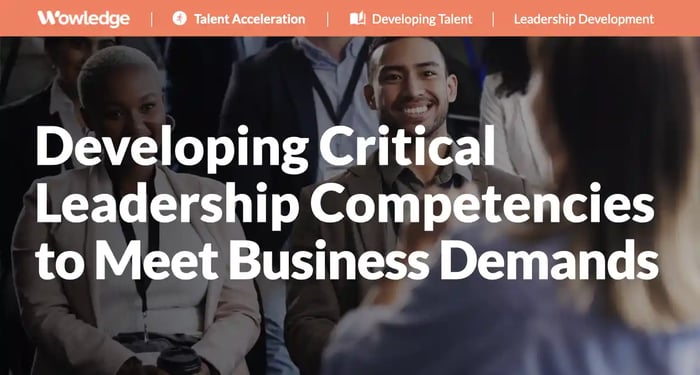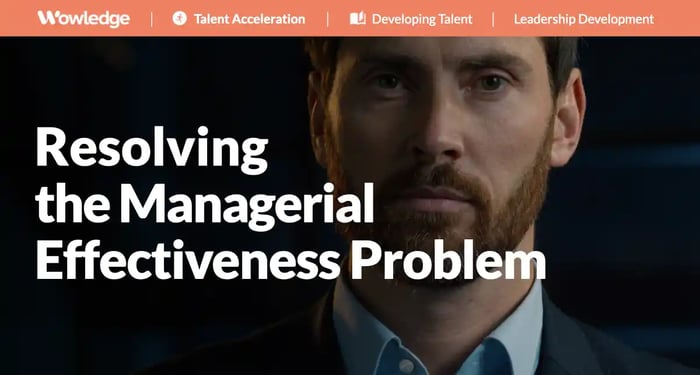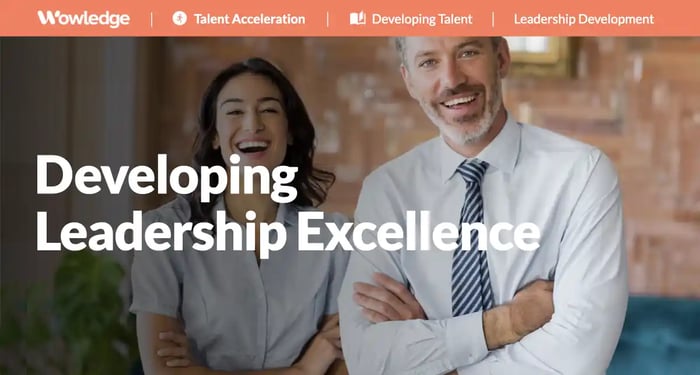Table of Contents
Leading an organization has become dizzying for many, with new generations of workers and managers having unique styles and demands, a labor shortage complicating organizational growth plans, a new (U.S.) administration with an ambitious trade and regulatory change agenda, and the rapid ascent of artificial intelligence as a significant disruptor of staffing and work methods. Managing change is difficult enough when initiated by an organization on its own, but managing a business in the face of so many external challenges can be overwhelming. Helping guide leaders through such factors creates new pressure on enterprise leadership development priorities.
It can be credibly argued that leadership is in a crisis. Employee engagement levels are near their all-time low. In the past two years alone, trust in senior leaders has dropped dramatically, with only 32% of leaders and middle managers expressing confidence in them, while employees' trust in their immediate managers has fallen by over one-third, from 46% to 29%. Further evidence comes from the leaders themselves, with 71% reporting significant increases in stress levels, a 12.5% increase in just the past two years.
Even their future replacements are struggling, with 53% of middle managers reporting burnout at work. With only 20% of HR professionals reporting confidence in the abilities and readiness of their current bench players, the picture appears even bleaker. Worse yet is the finding that 21% of “high potential” (HiPo) individual contributors and 9% of HiPo leaders intend to leave their companies in the coming year.
Leadership development priorities traditionally focus on preparing and building leaders' skills related to a static set of competencies and capabilities, often not updated for years. Given the current environment and circumstances, adjusting and adapting leadership development priorities to better manage difficult and complex market and external circumstances, stress (for self and others), changing employment dynamics and employee expectations, and team effectiveness are necessary.
The reason? Leadership is a competitive differentiator. 2016 research from The Corporate Executive Board and SHL found that organizations with stronger leadership teams generate twice (2X) the revenue and profit growth of competitors with weaker leadership. Therefore, updating and reinvigorating leadership development priorities is a must.
Current leadership development approaches have not proved to be effective
Traditional approaches to leadership development are not delivering on their promise. Senior leaders hold a surprisingly dim view of the programming in their organizations, with only 23% rating leadership development as “high quality.” Data suggests that barely 10% of the $200 billion spent annually for corporate training and development in the U.S. delivers concrete results. Much has been written about signature programs and using coaching and mentoring, but career development guidance, direct manager coaching, and action learning project assignments are too often neglected.
An article in HBR suggested that learning does not translate to better organizational performance because people soon revert to their old ways of doing things. It further points to what can be summarized as 1) a lack of follow-up and post-class reinforcement and accountability for behavioral changes and 2) a poorly defined “leadership culture” where shared understanding, expectations, and collaborative behaviors from and between leaders are self-sustaining. Without support and coaching from direct supervisors and managers for adopting and exhibiting new skills and behaviors, the likelihood of changes in approaches to leading and managing others is minimized. Leadership development priorities sadly underemphasize the post-learning environment as a development opportunity.
Traditional programs are also seen as not sufficiently responsive to the needs and preferences of the most significant portion of new leaders and HiPos, the Millennials. Born between 1981 and 1996, they are between the ages of 29 and 44 and represent the prime age range for managerial and leadership succession roles. Some research has found that only 36% of millennials report that their management and leadership skills were adequately developed, which is problematic when only 18% of those same millennials felt confident in their current leadership capabilities.
Other studies suggest that only 28% of leadership development program participants are Millennials. This starkly contrasts their preferences and motivations, with 72% of them valuing (some say crave) feedback, coaching, and learning or growth opportunities as the primary drivers of their motivation to continue with their current employer.
Leadership development priorities must focus on the skills and well-being of current leaders and their future replacements. The question is, how to best accomplish that?

Leadership development priorities to best address business and employee needs
Many employers need to change their leadership development approaches. The most effective strategies are tailored to each organization's needs, culture, and maturity. Critical and highly effective tactics can be selected when building or enhancing a company-wide effort. The details of how these are developed and accomplished may differ from one organization to another. Still, the combination of strategic starting points with targeted delivery options makes for a comprehensive solution.
1. Understand what differentiates successful leaders
Defining what makes a successful leader in a particular organization is essential, and many fail to update those as time and corporate circumstances evolve. For example, changes in core product or service mix, business strategies, or market focus can significantly impact the profile of a successful leader. Other changes might include new leadership at the top, business declines that require a turnaround, a sudden hit product or service, or a plan to make a significant cultural/business shift to one of process excellence, a customer-first mentality, or innovation.
The key is identifying the capabilities and behaviors supporting the company's strategy and direction. Many organizations define a leadership competency model that clarifies the core capabilities that define exceptional leaders. Others rely upon highly credible and research-based models from vendors such as the Center for Creative Leadership (CCL), Development Dimensions International (DDI), Korn Ferry, and the RBL Group. Whether internally developed or purchased externally (and tailored), bringing clarity to the requirements of successful leaders and how those are related to the achievement of the business mission and priorities is essential.
Those should be well-communicated and understood by all leaders and managers and used across talent processes for consistency and objectivity in assessing leaders. They are best used as criteria for performance evaluations, skills gap assessments, HiPo or succession management status assignments, development planning, and promotion considerations.
2. Develop more effective leaders and managers
Aside from defining the competencies, there is a need to clarify how managers should conduct themselves and guide the work of their subordinates. Managers need specific guidance about how to gain the workers' trust reporting to them and how to lead and develop them in ways that support the larger organization’s goals and objectives. For example, DDI has identified three managerial behaviors that drive a higher level of employee trust:
- Actively support employee development (11X more likely to trust their manager)
- Provide regular feedback (9X more likely to trust their manager)
- Deliver ongoing and effective coaching (employee)
Assessing all leaders' leadership skill levels and gaps continuously enables targeted and personalized improvement plans, evaluation of readiness to move into other or higher-level roles, and suitability for future promotions. Critical leadership skills such as strategic thinking and action, managing change, influencing others, cultivating networks and partnerships, coaching and engaging employees, and conflict resolution are difference-makers in the most successful leaders. Sadly, only 22% of HR organizations currently assess and consider key skills such as those as leadership development priorities.
3. Improve leadership development programming
Some program design considerations stem from research into best practices that address their daily challenges. DDI argues that a comprehensive program should address two primary “critical leadership” experiences: transformative and " micro.” Transformative experiences are associated with significant, new, or unique challenges, such as taking on a new role or designing and executing a new strategy. In contrast, micro experiences are shorter but equally intense and impactful, such as a corrective performance or career options discussion with a subordinate. Each requires a combination of education, practice, and experience to learn and become adept at.
Using the concept of integrating related experiences to build capability, creating an expectation and culture of continuous learning by leaders drives long-term benefits. Top leaders are expected to be champions, role models, accountability partners, and guides to their direct reports. The senior leaders who report to them are expected to cascade such behaviors and expectations downward through their organizations.
Secondly, leadership development priorities should include multi-modal learning that supports both longer-term and in-the-moment learning for leaders. That means leaders should expect to participate in strategic skills building through group-based signature programs, discussions, and classes while receiving timely coaching and guidance from online resources, their direct supervisors, and other experts (e.g., HRBPs).
Next, learning plans should be personalized and tailored to the individual leader’s needs and skill gaps. The availability of AI-driven learning platforms takes advantage of ongoing skill assessments to recommend learning paths and programs. It can alter direction within an eLearning course based on the leader's competence in skill checks that are embedded throughout the material. Individual development plans (IDPs) should be customized yearly (or more) based on identified skill growth and gaps, likely next steps, and future roles identified in talent reviews and succession planning exercises.
Finally, while overreliance on signature leadership development programs should be avoided as the primary source of leadership development, they should be a unique opportunity for people at similar levels to come together, get insights from external experts, solve problems in teams (action learning), and build stronger internal networks. These should also be used to evaluate participants using direct (and structured) observation of their capabilities, primarily related to collaboration, flexibility, agility, and interpersonal and emotional intelligence skills.
4. Focus on experiential learning
As we have seen, the Millennial generation prefers learning through hands-on experience. With classroom learning retention rates long-estimated at only 10%, offering guided learning through experience provides enormous advantages over other learning modalities. The structured and formal use of special project assignments, cross-functional learning, and group coaching sessions expose people to different perspectives, experiences, and points of view.
Similarly, career development and pathing should be used as leadership development activities. Integrating career development, succession planning, talent reviews, and leadership development creates an environment where learning happens on the job. In that vein, consider a job rotation program for HiPos, Managers, and Leaders that regularly moves them between a) direct line authority (BU or customer-facing), b) subject matter expert (SME) or research-type roles (R&D, business development, new venture), and c) staff jobs (strategy, community affairs, COE). Through these moves, strategy development, innovation, and customer focus skills can be developed in each HiPo and leader throughout their careers. At the same time, this can help address the leadership and managerial burnout that plagues those in leadership roles.
5. Listen to leaders
When identifying leadership development priorities, consider their input to increase engagement and motivate participation. Interestingly, what leaders report as the most effective and beneficial learning experiences include developmental assignments, coaching from their current manager, instructor-led training, leadership assessments, eLearning, external coaching, formal mentoring, and simulations.
The use of surveys is a good start. Still, the value attained from human-centered design approaches such as design thinking brings leaders into the strategy and program design, development, and evaluation cycle in ways that can generate uniquely tailored programming with the buy-in of senior leaders and their future replacements.
6. Increase coaching and mentoring
Having leaders at all levels coaching their direct reports regularly addresses workers' needs and preferences across various skills and job levels. Leaders and managers flourish when their leaders are prepared and equipped to provide solid and well-informed guidance on ongoing job performance, development needs, enhancement opportunities, career choices, and direction.
Sadly, the number of companies relying on coaching for leadership development (and having a coaching culture) has dropped significantly over the past 5-10 years from 79% to 67%. Similarly, organizations that rely on external coaches working with their executives, senior leaders, and HiPos have dropped from 53% to 44%.
That said, the trend is counterintuitive, as leaders who report receiving quality coaching from their direct supervisor are 4.3X more likely to report that they have a clear leadership development path and, perhaps more impressive, 2.7X more likely to feel accountable for being an effective leader.

Related and integrated opportunities to improve leadership development
Leadership development priorities should be viewed from a longer lens, as the quality of their development is only part of their experience as organizational leaders. Frustrations over decision-making autonomy, burdensome administrative processes, under-resourced teams, and inadequate talent management below them can lower their engagement and limit their productivity. With those in mind, other crucial strategies can simplify their lives and allow a focus on the most impactful leadership development priorities.
Address manager experience issues
Consider how operational issues are barriers to managerial and leadership focus on managing and developing talent, meeting customer requirements, achieving operating and business goals, and continuously developing their skills. Given their disproportional influence on operational outcomes, the “leadership experience” (LX) should be addressed in much the same ways as employee experience (EX) and customer experience (CX) are prioritized.
Understanding the “friction” leaders at each level (executive, senior, middle management) experience as they focus on providing vision, leading others, and practicing and developing the skills and capabilities needed for advancement should be an ongoing effort. They can then lead to actions that improve process efficiencies and ease the often unnecessary (or improvable) burdens placed on them as decision-makers and approvers.
Review leadership roles and responsibilities
Similar to improving work processes, evaluating the design of leadership jobs at all levels is essential. Given the reported stressors, levels of burnout, and desire to leave leadership roles, a signal is being sent that many leadership jobs have become overwhelming to many.
Use job design, human-centered design, and EX methods to evaluate jobs and identify sources that make the jobs harder. Look at administrative systems and processes and redefine the need for approvals as control and (leadership culture-driven) comfort mechanisms. Push decision-making responsibilities down to the most appropriate level and ease administrative system and process requirements to prepare future leaders better and increase efficiencies. Consider processes and permissions that can help leaders identify low-value tasking that can be set aside and formally change goal priorities as new and more immediate tasks arise.
Review and revamp succession management
Given the burnout and related challenges, consider how to bolster leadership development with more robust succession management processes. Start by enhancing the leadership competency model to include managing ambiguity and stress as possible selection and development levers.
Next, build larger replacement talent pools by proactively identifying future leaders with formal potential assessments, skills databases, and AI tools. Consider having the recruitment team add high-quality external candidates as possible future leadership hires. Develop a process for earlier identification of future leaders and provide them with live development opportunities that test their moxie while developing their skills, capabilities, and experience bases.
Create a more supportive environment
As we have seen, taking care of leaders and their future replacements is challenging in the current environment. Return-to-work policies, continued growth in employee surveillance practices, low engagement, loss of trust in leadership, and high turnover and intention to leave create tremendous pressure and stress on leadership. Even so, leadership development priorities should focus on improving the work environment for every employee.
Research from DDI found that leaders who are working in supportive work environments (defined by work-life balance, organizational support, trust in their managers, and access to learning resources) are:
- 10X more likely to excel in their role.
- 3X less likely to experience chronic stress.
- 2X more likely to have energy at the end of the workday.
Creating capable leaders who are encouraged to develop such work environments is a worthy cause and one of the most crucial leadership development priorities. Because working in one impacts the quality of life for leaders and employees, it can also drive a culture of respect, balance, and continuous learning as part of a self-sustaining and virtuous employment cycle.
Relevant Practices & Tools
Advanced Leadership Development Practices to Drive the Business, Identify and Build Leaders Across Levels. >
Leadership Development (LD) is a business strategy-aligned approach structured around an idealized vision of how leaders will conduct themselves and the business... more »
Blending Learning and Development Delivery Methods to Optimize the Acquisition of Advanced Skills. >
Blended learning involves combining formal and informal learning methods. At its core, it has the power to teach and then offers the immediate opportunity to practice new capabilities... more »
Using Human-Centered Design to Build Employee and Customer-Focused Innovation Initiatives. >
Human-centered design is an approach to innovation that grounds any initiative (service, program, or product) in real human needs by engaging the end-users in the design process... more »
Developing Leaders Across Multiple Levels of Management. >
Advanced leadership development is designed to not only develop current executives, but "leaders" in all levels of the organization... more »
The Coach Effectiveness Assessment Tool: Apply a Questionnaire for Employees Providing Feedback on Coaches' Effectiveness and Prowess. >
The template helps assess the quality of external and/or internal coaches’ behaviors from their individual employee clients... more »
About Wowledge
Wowledge is the expert-driven platform for lean teams building strategic HR programs. Members enjoy access to up-to-date best practices, step-by-step guides, tools, templates, and insights to accelerate the design and implementation of all key HR programs and processes.
Since each organization has unique characteristics, needs, and aspirations, Wowledge's practices are developed utilizing an exclusive stage-based approach—from Core to Advanced to Emerging—that reflects distinct levels of sophistication to meet our members where they are.
Build strategic HR programs with refreshingly easy-to-follow best practices.
Get started for FREE! Learn more.









